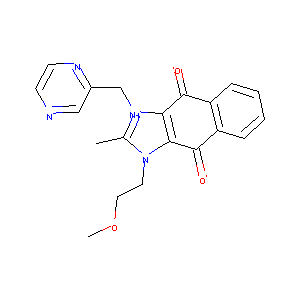| DOT Name |
DOT ID |
UniProt ID |
Mode of Action |
REF |
|
3-hydroxy-3-methylglutaryl-coenzyme A reductase (HMGCR)
|
OTRT3F3U
|
HMDH_HUMAN
|
Increases Expression
|
[12] |
|
Hydroxymethylglutaryl-CoA synthase, cytoplasmic (HMGCS1)
|
OTCO26FV
|
HMCS1_HUMAN
|
Increases Expression
|
[12] |
|
Isopentenyl-diphosphate Delta-isomerase 1 (IDI1)
|
OTGM06VJ
|
IDI1_HUMAN
|
Increases Expression
|
[12] |
|
Squalene monooxygenase (SQLE)
|
OT0GGRDO
|
ERG1_HUMAN
|
Increases Expression
|
[12] |
|
Cyclin-G2 (CCNG2)
|
OTII38K2
|
CCNG2_HUMAN
|
Increases Expression
|
[12] |
|
Programmed cell death protein 4 (PDCD4)
|
OTZ6NXUX
|
PDCD4_HUMAN
|
Increases Expression
|
[12] |
|
Kelch-like protein 24 (KLHL24)
|
OTWZSX5C
|
KLH24_HUMAN
|
Increases Expression
|
[12] |
|
Protein FAM200C (FAM200C)
|
OTZOXUEK
|
F200C_HUMAN
|
Increases Expression
|
[12] |
|
Cytochrome P450 1A1 (CYP1A1)
|
OTE4EFH8
|
CP1A1_HUMAN
|
Decreases Expression
|
[13] |
|
Aromatase (CYP19A1)
|
OTZ6XF74
|
CP19A_HUMAN
|
Decreases Expression
|
[13] |
|
Catechol O-methyltransferase (COMT)
|
OTPWKTQG
|
COMT_HUMAN
|
Increases Expression
|
[13] |
|
G1/S-specific cyclin-D1 (CCND1)
|
OT8HPTKJ
|
CCND1_HUMAN
|
Decreases Expression
|
[13] |
|
Caspase-3 (CASP3)
|
OTIJRBE7
|
CASP3_HUMAN
|
Increases Activity
|
[13] |
|
C-X-C chemokine receptor type 4 (CXCR4)
|
OTUFSBX2
|
CXCR4_HUMAN
|
Decreases Expression
|
[13] |
|
Cytochrome P450 1B1 (CYP1B1)
|
OTYXFLSD
|
CP1B1_HUMAN
|
Decreases Expression
|
[13] |
|
Estrogen receptor beta (ESR2)
|
OTXNR2WQ
|
ESR2_HUMAN
|
Decreases Expression
|
[13] |
|
NPC intracellular cholesterol transporter 1 (NPC1)
|
OTRIPICX
|
NPC1_HUMAN
|
Increases Expression
|
[14] |
|
Ubiquitin-like protein ATG12 (ATG12)
|
OTJRO09Y
|
ATG12_HUMAN
|
Increases Expression
|
[15] |
|
Ubiquitin-like modifier-activating enzyme ATG7 (ATG7)
|
OTVT4YA1
|
ATG7_HUMAN
|
Increases Expression
|
[15] |
|
Phospholipid-transporting ATPase ABCA1 (ABCA1)
|
OT94G6BQ
|
ABCA1_HUMAN
|
Increases Expression
|
[14] |
|
T-cell surface glycoprotein CD8 alpha chain (CD8A)
|
OTDWQJXK
|
CD8A_HUMAN
|
Decreases Expression
|
[16] |
|
Cellular tumor antigen p53 (TP53)
|
OTIE1VH3
|
P53_HUMAN
|
Increases Phosphorylation
|
[15] |
|
T-cell surface glycoprotein CD3 epsilon chain (CD3E)
|
OT13LE5J
|
CD3E_HUMAN
|
Decreases Expression
|
[16] |
|
Poly polymerase 1 (PARP1)
|
OT310QSG
|
PARP1_HUMAN
|
Increases Cleavage
|
[15] |
|
Apoptosis regulator Bcl-2 (BCL2)
|
OT9DVHC0
|
BCL2_HUMAN
|
Decreases Expression
|
[16] |
|
T-cell-specific surface glycoprotein CD28 (CD28)
|
OTT5XJST
|
CD28_HUMAN
|
Decreases Expression
|
[16] |
|
B-lymphocyte antigen CD19 (CD19)
|
OTCPF9NF
|
CD19_HUMAN
|
Decreases Expression
|
[16] |
|
Transcription factor E3 (TFE3)
|
OTM99ZWH
|
TFE3_HUMAN
|
Decreases Phosphorylation
|
[17] |
|
Sphingosine 1-phosphate receptor 1 (S1PR1)
|
OTLTXDQT
|
S1PR1_HUMAN
|
Decreases Activity
|
[18] |
|
Ribosomal protein S6 kinase beta-1 (RPS6KB1)
|
OTAELNGX
|
KS6B1_HUMAN
|
Decreases Phosphorylation
|
[15] |
|
Mitogen-activated protein kinase 3 (MAPK3)
|
OTCYKGKO
|
MK03_HUMAN
|
Increases Phosphorylation
|
[15] |
|
Mitogen-activated protein kinase 1 (MAPK1)
|
OTH85PI5
|
MK01_HUMAN
|
Increases Phosphorylation
|
[15] |
|
CD40 ligand (CD40LG)
|
OT75Z6A6
|
CD40L_HUMAN
|
Decreases Expression
|
[16] |
|
RAC-alpha serine/threonine-protein kinase (AKT1)
|
OT8H2YY7
|
AKT1_HUMAN
|
Decreases Phosphorylation
|
[15] |
|
C-C chemokine receptor type 7 (CCR7)
|
OTHFUOYE
|
CCR7_HUMAN
|
Decreases Expression
|
[16] |
|
Serine/threonine-protein kinase mTOR (MTOR)
|
OTHH8KU7
|
MTOR_HUMAN
|
Decreases Phosphorylation
|
[15] |
|
C-C chemokine receptor type 4 (CCR4)
|
OT68KZ9B
|
CCR4_HUMAN
|
Decreases Expression
|
[16] |
|
Potassium voltage-gated channel subfamily H member 2 (KCNH2)
|
OTZX881H
|
KCNH2_HUMAN
|
Decreases Activity
|
[19] |
|
Sequestosome-1 (SQSTM1)
|
OTGY5D5J
|
SQSTM_HUMAN
|
Decreases Expression
|
[15] |
|
Receptor-interacting serine/threonine-protein kinase 1 (RIPK1)
|
OTC41R1E
|
RIPK1_HUMAN
|
Increases Expression
|
[15] |
|
Histone deacetylase 1 (HDAC1)
|
OTQDNOXZ
|
HDAC1_HUMAN
|
Affects Binding
|
[20] |
|
Caspase-8 (CASP8)
|
OTA8TVI8
|
CASP8_HUMAN
|
Increases Cleavage
|
[15] |
|
Forkhead box protein P3 (FOXP3)
|
OTA9Z9OC
|
FOXP3_HUMAN
|
Decreases Expression
|
[16] |
|
Autophagy protein 5 (ATG5)
|
OT4T5SMS
|
ATG5_HUMAN
|
Increases Expression
|
[15] |
|
Ubiquitin-like-conjugating enzyme ATG3 (ATG3)
|
OT28VBVK
|
ATG3_HUMAN
|
Increases Expression
|
[15] |
|
Receptor-interacting serine/threonine-protein kinase 3 (RIPK3)
|
OTL1D484
|
RIPK3_HUMAN
|
Increases Expression
|
[15] |
|
Sphingosine kinase 2 (SPHK2)
|
OTNFG52M
|
SPHK2_HUMAN
|
Increases Phosphorylation
|
[20] |
| ------------------------------------------------------------------------------------ |
|
|
|
|


